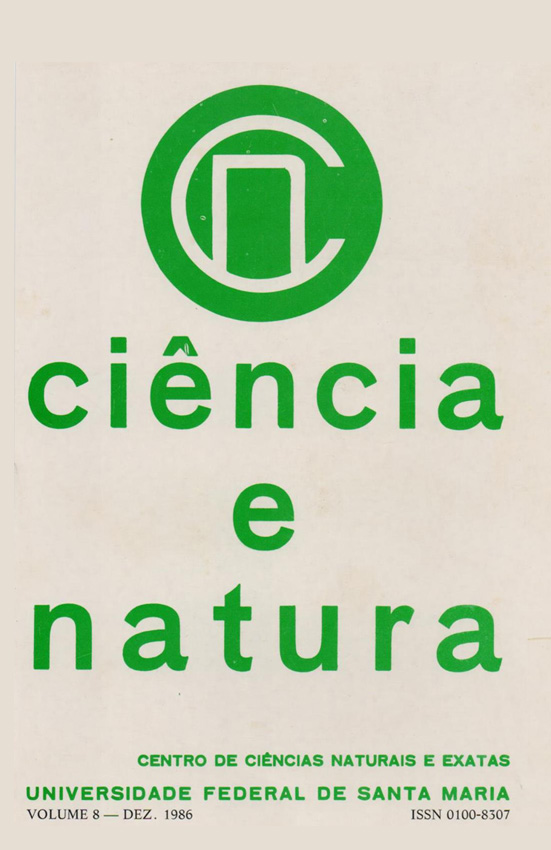Hexametonium effect on the contraction of the smooth muscle
DOI:
https://doi.org/10.5902/2179460X25441Abstract
Animals poisoning by ingestion of Ramaria flava brunnescens fungus found in Eucalipto groves is common in Southern Brazil. This poisoning does not have an effective antidote yet and it is common to avoid the toxicity by removing the animals from these fields or by using atropin when fungus intoxication signals appear. Present work was reallized to elucidate the manner and place of action of this fungus aqueous extract on isolated guinea pig ileum. For this purpose, we used Magnus Bath and strain transducer to Physiograph connect. Experiences were realized with 18 ileum tested with 10 mcg Nicotine. 24.600 mcg Ramaria flavo brunnescens fungus' aqueous extract and 30 mcg Hexametonium. Those concentrations were choosen from pilot experiences. The results showed that uses of this fungus extract provokes smooth muscle contraction similar to that of nicotin, the difference between both occurs due to Hexametone blockade impossibility. This fact suggests that the death mechanism of animals that eat this fungus is not due to ganglionar stimulation.
Downloads
References
BARROS, S.S.: Da possivel incidência da toxicose pelo selênio em bovinos no Rio Grande do Sul. Dipan.:11(121-2):10-3, 195B.
BAUER, A.G.; LARANJA, R.J.; SANTOS, A.G.: Sobre a etiologia do chamado "Mal do Eucalipto". Arquiv. Instit. Pes. Vet. Desidério Finamor", 3: 85-90, 1960.
BEVAN, J.A.; Fundamentos de Farmacologia, São Paulo, Editora Harper & Row do Brasil, pp 589, 1979.
CHAGAS, A.M.; PIRES, T.E.; MAGALHÃES, H.M.: Atividade da atropina como provável bloqueadora do extrato aquoso do fungo Ramaria flavo brunnescens na musculatura lisa. Rev. Centro de Ciências Rurais, 8(3):211-6,1978.
CORNER, E.J.T.: Species of Ramaria (Clavariaceas) without clamps. Br. Mycol. Soc., 49(1):101-13, 1966.
FIDALGO, O & FIDALGO, M.E.P.K.: A poisonous Ramaria from Southern Brazil. Rickia, 5:71-91, 1966.
SANTOS, M.N.; BARROS, S.S.; BARROS, S.L.: Intoxicações em bovinos pelo cogumelo Ramaria flavo brunnescens. Pesq. Agropec.Bras., 10:105-9,1975.
ZANINI, A.C.; OGA, S.: Farmacologia aplicada, São Paulo, Editora Atheneu, pp 625,'1979.
Downloads
Published
How to Cite
Issue
Section
License
To access the DECLARATION AND TRANSFER OF COPYRIGHT AUTHOR’S DECLARATION AND COPYRIGHT LICENSE click here.
Ethical Guidelines for Journal Publication
The Ciência e Natura journal is committed to ensuring ethics in publication and quality of articles.
Conformance to standards of ethical behavior is therefore expected of all parties involved: Authors, Editors, Reviewers, and the Publisher.
In particular,
Authors: Authors should present an objective discussion of the significance of research work as well as sufficient detail and references to permit others to replicate the experiments. Fraudulent or knowingly inaccurate statements constitute unethical behavior and are unacceptable. Review Articles should also be objective, comprehensive, and accurate accounts of the state of the art. The Authors should ensure that their work is entirely original works, and if the work and/or words of others have been used, this has been appropriately acknowledged. Plagiarism in all its forms constitutes unethical publishing behavior and is unacceptable. Submitting the same manuscript to more than one journal concurrently constitutes unethical publishing behavior and is unacceptable. Authors should not submit articles describing essentially the same research to more than one journal. The corresponding Author should ensure that there is a full consensus of all Co-authors in approving the final version of the paper and its submission for publication.
Editors: Editors should evaluate manuscripts exclusively on the basis of their academic merit. An Editor must not use unpublished information in the editor's own research without the express written consent of the Author. Editors should take reasonable responsive measures when ethical complaints have been presented concerning a submitted manuscript or published paper.
Reviewers: Any manuscripts received for review must be treated as confidential documents. Privileged information or ideas obtained through peer review must be kept confidential and not used for personal advantage. Reviewers should be conducted objectively, and observations should be formulated clearly with supporting arguments, so that Authors can use them for improving the paper. Any selected Reviewer who feels unqualified to review the research reported in a manuscript or knows that its prompt review will be impossible should notify the Editor and excuse himself from the review process. Reviewers should not consider manuscripts in which they have conflicts of interest resulting from competitive, collaborative, or other relationships or connections with any of the authors, companies, or institutions connected to the papers.






